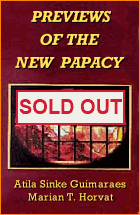Art & Architecture
 |
 |
 |
 |
 |
 |
 |
The Vatican Exposition at the Venice Biennale
One of the most under-reported stories of 2013 in the English Catholic press was, in my opinion, the Vatican’s exhibition – called pavilion or stand - in the 55th Venice Biennale. I believe that most American Catholics are unaware of the Biennale and its significance as the most avant-garde modern art show in the world.
Since we were not informed, the lack of reaction to that extravagant and unorthodox exhibition at the 2013 Venice Biennale – from June to November – was understandable. Since it is better to deal with it late than never, let me repair this information void by giving my readers a succinct report on what happened.
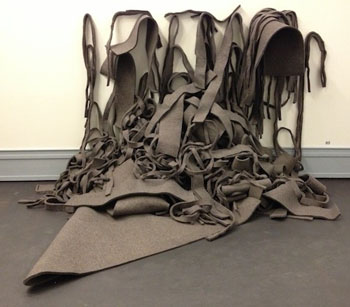
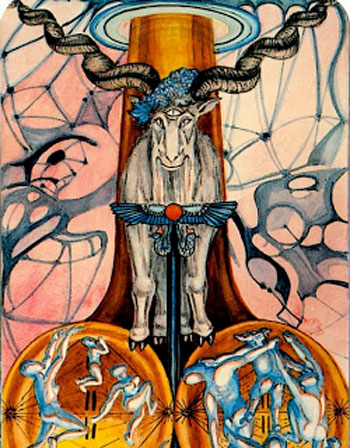 Biennales in Italian, or Biennials in English, are every-other-year expositions of modern art to promote it. The first and most important one is the Venice Biennale that has taken place since 1895. Today, there are many Biennial expositions in different cities.
Biennales in Italian, or Biennials in English, are every-other-year expositions of modern art to promote it. The first and most important one is the Venice Biennale that has taken place since 1895. Today, there are many Biennial expositions in different cities.
Modern artists are invited to bring their works and display them in stands to the public. A jury selects the most relevant from all those works and awards them prizes. This produces an artificial fame for the artists and inflates an artificial market for this ugly and anti-natural art, which otherwise would die, rejected by the good sense of the public.
For the first time in history, in 2013, the Vatican accepted the invitation to join the Venice Biennale.
The few articles I found in English praised the Vatican for engaging with the modern art world. This it certainly did. It opened a stand with an exhibition based on the Genesis theme, which had nothing to do with the Catholic traditional teaching on Creation.
The initiative of this exhibition was the brainchild of Cardinal Gianfranco Ravasi, head of the Ponfifical Council for Culture, who quotes Hegel as easily as Amy Winehouse. Ravasi’s explicit aim was to “repair the broken marriage between art and faith” and show that the Church is open to modern culture, art and music.
He explains the Vatican exhibition as one such effort: "This for us is a germ, a seed to return to the hope that there can be even more commissions between churchmen, ecclesial figures and artists - quality contemporary artists." (“Vatican Re-Enters Art World,” AP)
Curator of the Vatican pavilion, Micol Forti, who is also the curator of contemporary art in the Vatican museums, agrees. "It's very important for the Holy See to be here. It's a different situation where you can create a space for a dialogue with different ideas, different ideological thinking, different religions," she said. (Ibid.)
Compliantly accepting Modern Art
It was only after the first Biennale in Venice in 1895, that the Modern Art movement caught on and acquired prestige and international fame. From its start, the Venice Biennale provided a visible venue for avant-garde movements and what the Church then wisely condemned as “blasphemous” art.
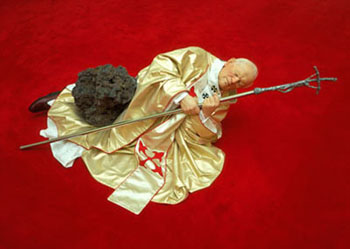 In the 1895 first edition, for example, the Patriarch of Venice Cardinal Giuseppe Sarto (future Pope St. Pius X) asked the mayor of Venice to ban Giacomo Grosso's Supreme Meeting, which featured a coffin surrounded by naked women, as morally offensive. The mayor refused to take it down, and later the picture won a prize at the Show.
In the 1895 first edition, for example, the Patriarch of Venice Cardinal Giuseppe Sarto (future Pope St. Pius X) asked the mayor of Venice to ban Giacomo Grosso's Supreme Meeting, which featured a coffin surrounded by naked women, as morally offensive. The mayor refused to take it down, and later the picture won a prize at the Show.
Although after Vatican II the Church has been making peace with modern art, Vatican officials still complained about the 1990 Biennale when the American exhibition showed Pope Piece, an image of John Paul II together with an image of a penis. This was meant as a critique of the Church’s opposition to condoms as a way to fight AIDS. Vatican officials also expressed outrage at the 2001 Italian pavilion that featured La Nona Ora, or The Ninth Hour - a life-size figure of John Paul being crushed by a black meteorite.
But now all that bad fame is being set aside by the Conciliar Popes, no grudges, nothing to block the way of modern artists is the rule. The most important thing is opening up a dialogue with modern art. So, in 2013 the Vatican joined 87 other nations and entered this cacophonous, blasphemous and often satanic festival of arts for the first time.
Creation, Un-Creation and Re-Creation
For its inaugural presentation in the Biennale, the Vatican picked three modern artists and gave each of them a theme – Creation (based on the first 11 chapters of Genesis), Un-Creation (man’s destruction of God’s work), and Re-Creation. Vatican officials said they weren't sure of the artists' faiths and that it did not matter. These artists – none practicing Catholics to my knowledge – were given absolutely free reign to interpret the themes as they saw fit.
And so let us go to the Vatican stand at the Venice Biennale to see the result. But, let me warn you, do not expect anything that looks remotely religious.
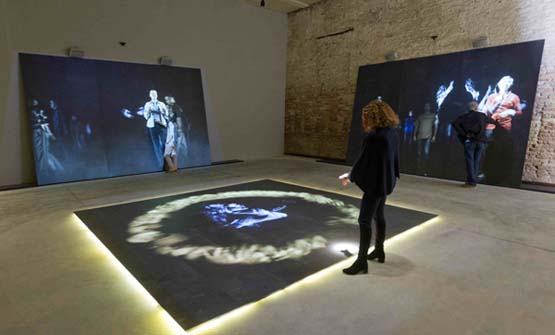 The Milan-based multimedia group Studio Azzurro was selected for Creation. In the center of a darkened room is a board of stone. When touched, it comes alive, so to speak, creating images and sounds from the animal and vegetable kingdoms.
The Milan-based multimedia group Studio Azzurro was selected for Creation. In the center of a darkened room is a board of stone. When touched, it comes alive, so to speak, creating images and sounds from the animal and vegetable kingdoms.
This supposedly was an “interactive creation” where man plays his part in generating life. The only thing missing in this interpretation of Genesis was God.
To complete the work, an interactive wall screen showed a tangle of outreached hands while the viewer heard the sounds of children and animals. A second interactive screen showed people – actually inmates of Milan’s Bollate Prison - randomly walking. The viewer touched one of them and the person stopped to recite his family tree, disappearing when the viewer’s hand was released.
This was supposed to “trigger a dialogue, awash with echoes and reverberations, between the vegetable and animal kingdoms and the human dimension, " explained the official Vatican News Network about the Vatican’s strange godless representation of Creation.
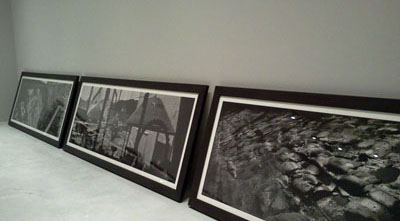 The Un-Creation room was filled with 18 bleak black and white photographs of Czech-French photographer Koudelka. These works were meant to present the destruction man has wreaked on the environment: war, environmental degradation and the conflict between nature and industry.
The Un-Creation room was filled with 18 bleak black and white photographs of Czech-French photographer Koudelka. These works were meant to present the destruction man has wreaked on the environment: war, environmental degradation and the conflict between nature and industry.
The photos were simply propped up on a floor to resemble a ruin as part of the theme.
No reference to the original sin of Adam and Eve, the promise of Redemption or any Catholic theme was made. One could only see man’s destruction of the environment and the “inhumanity of man,” the new progressivist notion of sin that has being fostered by the concilar Popes.
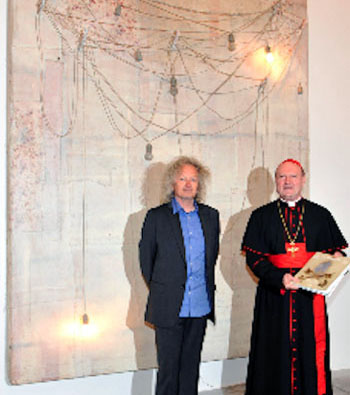 Finally, one could visit an even bleaker room, if one can imagine it: the third installment titled Re-Creation. Four large colorless “works” by Australian-born US painter Lawrence Carroll filled the walls. Instead of a Re-Creation inspired by the Redemption of Our Lord Jesus Christ and the love of God and His glory, one found patched canvases mounted with recycled materials and objects.
Finally, one could visit an even bleaker room, if one can imagine it: the third installment titled Re-Creation. Four large colorless “works” by Australian-born US painter Lawrence Carroll filled the walls. Instead of a Re-Creation inspired by the Redemption of Our Lord Jesus Christ and the love of God and His glory, one found patched canvases mounted with recycled materials and objects.
Re-Creation was as dismal, ugly and empty as the Modern Art that inspired it. I imagine the recycled miserablist canvases might please Pope Francis, although he may not be so delighted with the costs and entry fee for the Vatican Pavilion, which topped $1 million.
The three-room Vatican stand was not touching at all. The Catholic viewer, who seeks to find God is His Creation, was left cold and confused.
Who could imagine we would reach a state where the Vatican would proudly present a representation of Creation at an international Art Exhibit that made no reference to God?
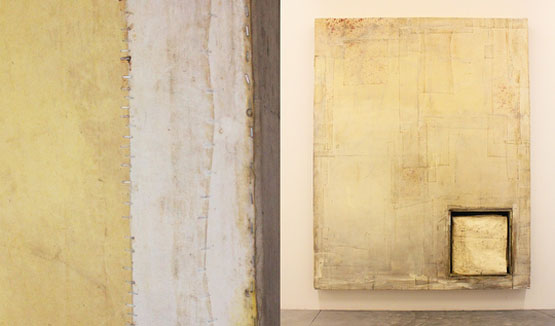

Since we were not informed, the lack of reaction to that extravagant and unorthodox exhibition at the 2013 Venice Biennale – from June to November – was understandable. Since it is better to deal with it late than never, let me repair this information void by giving my readers a succinct report on what happened.

Above, a sample titled 'Form'; below, a tarot card titled 'the Devil' by Aleister Crowley at the 2013 Biennale

Modern artists are invited to bring their works and display them in stands to the public. A jury selects the most relevant from all those works and awards them prizes. This produces an artificial fame for the artists and inflates an artificial market for this ugly and anti-natural art, which otherwise would die, rejected by the good sense of the public.
For the first time in history, in 2013, the Vatican accepted the invitation to join the Venice Biennale.
The few articles I found in English praised the Vatican for engaging with the modern art world. This it certainly did. It opened a stand with an exhibition based on the Genesis theme, which had nothing to do with the Catholic traditional teaching on Creation.
The initiative of this exhibition was the brainchild of Cardinal Gianfranco Ravasi, head of the Ponfifical Council for Culture, who quotes Hegel as easily as Amy Winehouse. Ravasi’s explicit aim was to “repair the broken marriage between art and faith” and show that the Church is open to modern culture, art and music.
He explains the Vatican exhibition as one such effort: "This for us is a germ, a seed to return to the hope that there can be even more commissions between churchmen, ecclesial figures and artists - quality contemporary artists." (“Vatican Re-Enters Art World,” AP)
Curator of the Vatican pavilion, Micol Forti, who is also the curator of contemporary art in the Vatican museums, agrees. "It's very important for the Holy See to be here. It's a different situation where you can create a space for a dialogue with different ideas, different ideological thinking, different religions," she said. (Ibid.)
Compliantly accepting Modern Art
It was only after the first Biennale in Venice in 1895, that the Modern Art movement caught on and acquired prestige and international fame. From its start, the Venice Biennale provided a visible venue for avant-garde movements and what the Church then wisely condemned as “blasphemous” art.

JPII struck by a meteor at the 2001 Biennale
Although after Vatican II the Church has been making peace with modern art, Vatican officials still complained about the 1990 Biennale when the American exhibition showed Pope Piece, an image of John Paul II together with an image of a penis. This was meant as a critique of the Church’s opposition to condoms as a way to fight AIDS. Vatican officials also expressed outrage at the 2001 Italian pavilion that featured La Nona Ora, or The Ninth Hour - a life-size figure of John Paul being crushed by a black meteorite.
But now all that bad fame is being set aside by the Conciliar Popes, no grudges, nothing to block the way of modern artists is the rule. The most important thing is opening up a dialogue with modern art. So, in 2013 the Vatican joined 87 other nations and entered this cacophonous, blasphemous and often satanic festival of arts for the first time.
Creation, Un-Creation and Re-Creation
For its inaugural presentation in the Biennale, the Vatican picked three modern artists and gave each of them a theme – Creation (based on the first 11 chapters of Genesis), Un-Creation (man’s destruction of God’s work), and Re-Creation. Vatican officials said they weren't sure of the artists' faiths and that it did not matter. These artists – none practicing Catholics to my knowledge – were given absolutely free reign to interpret the themes as they saw fit.
And so let us go to the Vatican stand at the Venice Biennale to see the result. But, let me warn you, do not expect anything that looks remotely religious.

Creation - man creating and interacting with man
This supposedly was an “interactive creation” where man plays his part in generating life. The only thing missing in this interpretation of Genesis was God.
To complete the work, an interactive wall screen showed a tangle of outreached hands while the viewer heard the sounds of children and animals. A second interactive screen showed people – actually inmates of Milan’s Bollate Prison - randomly walking. The viewer touched one of them and the person stopped to recite his family tree, disappearing when the viewer’s hand was released.
This was supposed to “trigger a dialogue, awash with echoes and reverberations, between the vegetable and animal kingdoms and the human dimension, " explained the official Vatican News Network about the Vatican’s strange godless representation of Creation.

UnCreation - man destroying the environment
The photos were simply propped up on a floor to resemble a ruin as part of the theme.
No reference to the original sin of Adam and Eve, the promise of Redemption or any Catholic theme was made. One could only see man’s destruction of the environment and the “inhumanity of man,” the new progressivist notion of sin that has being fostered by the concilar Popes.

Artist Carroll poses with Card. Ravisi before his work, a string of recycled light bulbs on a patched canvas
Re-Creation was as dismal, ugly and empty as the Modern Art that inspired it. I imagine the recycled miserablist canvases might please Pope Francis, although he may not be so delighted with the costs and entry fee for the Vatican Pavilion, which topped $1 million.
The three-room Vatican stand was not touching at all. The Catholic viewer, who seeks to find God is His Creation, was left cold and confused.
Who could imagine we would reach a state where the Vatican would proudly present a representation of Creation at an international Art Exhibit that made no reference to God?

Two more bleak modern art panels from Carroll's Re-Creation room

Posted January 27, 2014
______________________
______________________











